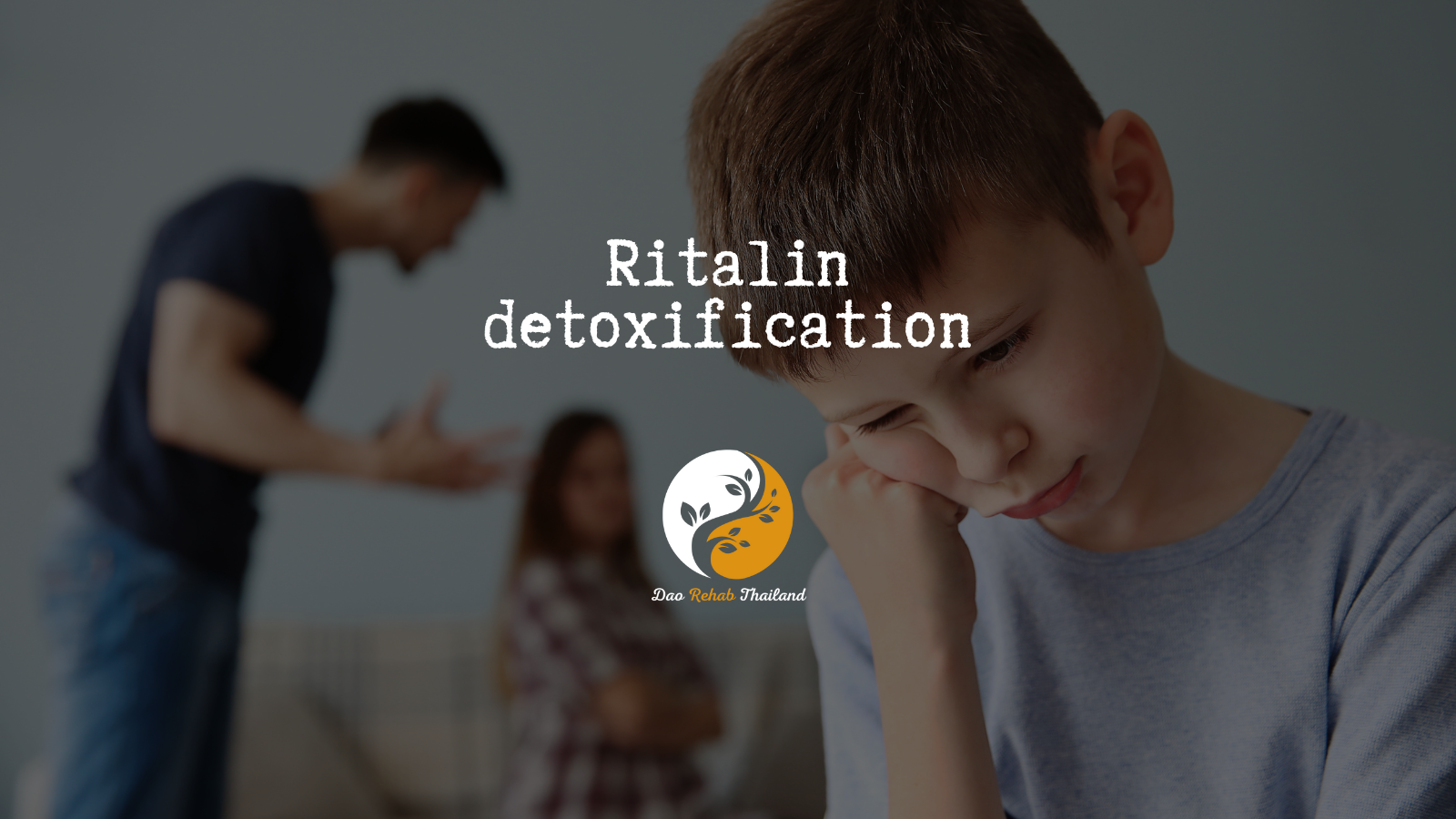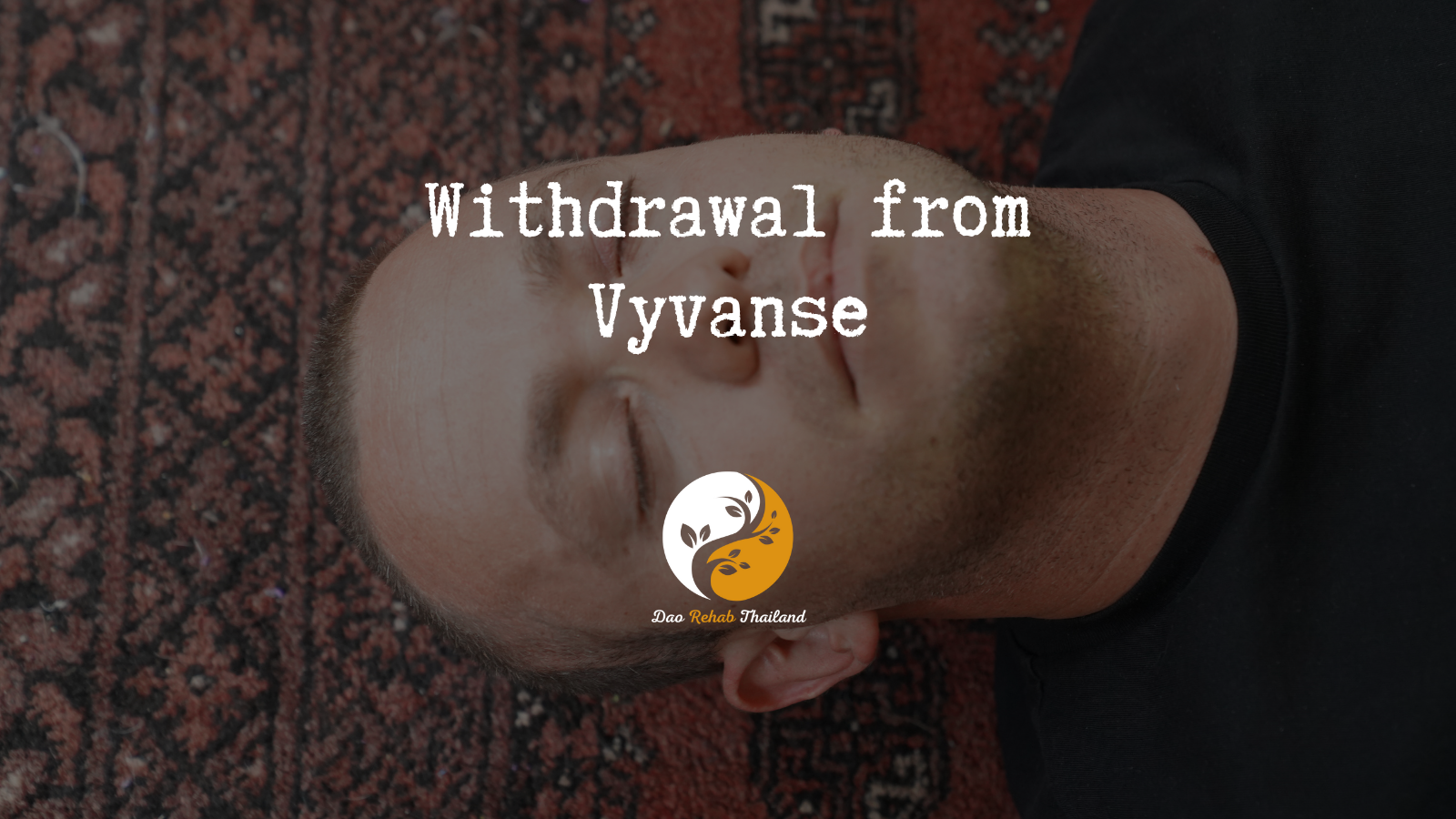
Ritalin detoxification in holistic rehab in thailand
Ritalin detoxification
“Turning the impossible into possible”

"Detox from Ritalin at a Luxury Holistic Center in Thailand and Israel"

Detox from Ritalin
Ritalin detoxification is a process intended for individuals who have developed a dependency or addiction to Ritalin (methylphenidate), a medication used to treat ADHD and other neurological disorders. Ritalin affects the central nervous system by increasing dopamine and norepinephrine levels in the brain, which helps improve concentration and reduce impulsivity. When used in high doses or over prolonged periods, physical and psychological dependency on the medication may develop.
"Holistic Center for Trauma, Addiction, and Mental Imbalance Treatment in Thailand"
“Come to the beginning of your journey to freedom from addiction to alcohol, drugs, and pills, and rediscover your life within the serene embrace of DaoTherapy Rehab in Thailand—where holistic healing meets empowering recovery.”
DaoTherapy Holistic Rehab
Key Elements of Ritalin Detox:
Medical Supervision: Ritalin detox must be conducted under medical supervision, as the body may experience withdrawal symptoms. These can include nausea, anxiety, muscle aches, and insomnia. A medical team will monitor and manage these symptoms to ensure the patient’s safety and comfort.
Holistic Therapies:
Holistic Therapies: Many detox programs incorporate holistic therapies such as mindfulness, yoga, and meditation to help individuals cope with stress and anxiety during the detox process. These therapies support the mind-body connection and contribute to overall recovery.
Tapering Process
Tapering Process: Ritalin detox often involves a gradual tapering of the drug to reduce withdrawal severity. Doctors will slowly decrease the dosage over time to allow the body to adjust to lower levels of the substance.
Psychological Support:
Psychological Support: Like any addiction recovery process, detox from Ritalin includes psychological support. This can involve counseling, therapy, or support groups to address the mental and emotional aspects of addiction.
Post-Detox Treatment:
Post-Detox Treatment: After completing detox, continuing treatment is crucial to prevent relapse. This often includes participation in ongoing therapy, group support, and the development of new coping strategies to maintain sobriety.
General Background and History of Ritalin:
Ritalin, also known by its generic name methylphenidate, was first synthesized in 1944 by chemist Leandro Panizzon, who worked for the Swiss pharmaceutical company Ciba (now part of Novartis). Originally, it was not intended for ADHD treatment; rather, it was developed as a central nervous system stimulant to address fatigue, depression, and other mental health conditions. The drug’s name, “Ritalin,” is said to be inspired by Panizzon’s wife, Rita, as she was one of the first to test it and reported improved energy and mood.
Early Uses and Development
Ritalin was initially used in the 1950s as a treatment for chronic fatigue, depression, and certain types of psychiatric conditions. During this time, researchers began to observe its stimulant effects on children with hyperactivity and attention issues. By the 1960s, methylphenidate became one of the leading treatments for what was then termed “hyperkinetic syndrome,” now known as Attention Deficit Hyperactivity Disorder (ADHD).
Ritalin’s Role in Treating ADHD
In the 1970s and 1980s, as awareness and diagnosis of ADHD grew, Ritalin became widely prescribed for children and adults with ADHD. Ritalin’s ability to increase dopamine and norepinephrine levels in the brain was found to help individuals with ADHD improve focus, control impulsivity, and reduce hyperactivity, making it a cornerstone in ADHD treatment.
As its popularity grew, Ritalin also became one of the most researched drugs for ADHD, with studies supporting its efficacy in managing symptoms and improving functioning in academic and social settings. It is classified as a Schedule II controlled substance in many countries due to its potential for abuse and dependence, as it has effects similar to amphetamines.
Mechanism of Action
Ritalin works by blocking the reuptake of dopamine and norepinephrine, increasing their levels in the brain and stimulating the central nervous system. This increased neurotransmitter activity helps regulate attention and behavioral control, which are often compromised in individuals with ADHD.
Rise in Popularity and Misuse
In the 1990s and 2000s, prescriptions for Ritalin surged as ADHD diagnoses increased, particularly in the United States. However, its stimulant properties and effects on focus and alertness also made it popular among individuals without ADHD, particularly students and professionals seeking enhanced concentration or alertness. This led to misuse and a rise in non-medical use, sparking concerns about addiction and dependency.
Modern Usage and Alternatives
Today, Ritalin remains a widely used medication for ADHD, though it now shares the market with other stimulants like Adderall (amphetamine-based) and non-stimulant options. Doctors continue to prescribe Ritalin due to its shorter duration of action, which allows for flexible dosing, and because it is effective for many patients. It is also used, though less commonly, to manage narcolepsy, a sleep disorder.
Ritalin’s history reflects its evolution from a treatment for fatigue to a widely prescribed medication for ADHD. Its stimulant effects on dopamine and norepinephrine levels make it effective for managing ADHD symptoms, though its potential for misuse requires careful prescription and monitoring.

contact us
Contact us with your questions
We would love to speak with you! Feel free to reach out with any questions.

get in touch
Schedule a free consultation
Schedule a free consultation with our team and let’s make things happen!
What You Need to Know About Ritalin Withdrawal:
Ritalin withdrawal can be challenging, particularly for those who have used it in high doses or over a long period. The withdrawal symptoms stem from the body’s adaptation to Ritalin’s stimulant effects on dopamine and norepinephrine, which help improve focus and reduce hyperactivity. Here’s what you need to know:
1. Symptoms of Ritalin Withdrawal
– Fatigue and Lethargy: Individuals often experience extreme tiredness and lack of energy as the brain readjusts to lower dopamine levels.
– Depression and Mood Swings: Withdrawal may lead to feelings of depression, irritability, and mood swings, due to decreased dopamine and norepinephrine.
– Anxiety and Restlessness: Anxiety is common, often accompanied by a feeling of unease or restlessness.
– Lack of Focus and Mental Fog: Cognitive abilities, including concentration and memory, may temporarily decline, causing “brain fog.”
– Changes in Appetite: Increased appetite is common, as stimulant medications tend to suppress hunger.
– Headaches: Headaches may arise due to changes in brain chemistry and stress on the nervous system.
2. Duration of Withdrawal
– Initial Phase (Days 1-3): The first symptoms, like fatigue, headaches, and increased appetite, often appear within a few hours to a day after the last dose.
– Acute Phase (Days 3-7): Mood-related symptoms such as anxiety, depression, and lack of motivation often peak in the first week.
– Post-Acute Withdrawal Syndrome (PAWS): Some symptoms, particularly mood and concentration issues, may persist for weeks or even months.
3. Managing Ritalin Withdrawal
– Gradual Tapering: Gradually reducing the dose under medical supervision can help minimize withdrawal symptoms and allow the body to adjust more comfortably.
– Supportive Therapies: Practices like cognitive-behavioral therapy (CBT), mindfulness, and relaxation techniques can help manage emotional symptoms like depression and anxiety.
– Balanced Diet and Hydration: Proper nutrition and hydration support the body’s recovery and can help with energy levels and mood stability.
– Exercise: Physical activity can naturally boost dopamine and serotonin levels, helping to alleviate mood symptoms and improve focus.
4. Why Medical Supervision is Important
– Withdrawal from Ritalin can involve physical and psychological challenges, and medical guidance can provide a structured tapering plan, symptom management, and support through emotional adjustments.
5. Long-Term Considerations
– For individuals using Ritalin for ADHD, alternative therapies or medications may be explored to avoid dependence on stimulants. For those who misuse Ritalin, therapy and support groups can provide coping strategies for managing concentration and stress without stimulant reliance.
Ritalin withdrawal involves physical and psychological symptoms that arise as the body readjusts to lower levels of dopamine and norepinephrine. Gradual tapering, medical support, and complementary therapies can help manage symptoms and support a successful recovery.
Characteristics of Ritalin Addiction:
Ritalin addiction can develop when the medication, typically prescribed for ADHD, is used in high doses, taken more frequently than prescribed, or misused for recreational purposes. Here are the main characteristics of Ritalin addiction:
1. Physical and Psychological Dependence
– Physical Dependence: Regular use of Ritalin can lead to physical dependence, meaning the body adapts to the drug, and withdrawal symptoms may occur when its use is reduced or stopped.
– Psychological Dependence: Psychological dependence can develop as individuals rely on Ritalin for focus, energy, or emotional regulation. This often leads to cravings for the drug to function or feel “normal.”
2. Tolerance
– Over time, individuals may develop a tolerance to Ritalin, requiring higher doses to achieve the same effects. This increase in dosage can lead to a pattern of misuse and heighten the risk of addiction.
3. Cravings and Compulsive Use
– One hallmark of addiction is intense cravings for Ritalin. Individuals may take Ritalin compulsively, even when they no longer need it for its intended therapeutic effects, and may continue using it despite knowing the negative consequences.
4. Loss of Control Over Use
– Individuals addicted to Ritalin often lose control over their use, taking it in higher doses or more frequently than prescribed. They may struggle to reduce or stop using the drug even when they recognize the harm it causes.
5. Neglect of Responsibilities and Social Withdrawal
– Addiction can lead to neglect of personal, social, or professional responsibilities. Individuals may miss work, school, or social commitments due to preoccupation with obtaining or using Ritalin. Social withdrawal and isolation are also common, as the focus shifts toward the drug.
6. Mood and Behavior Changes
– Ritalin addiction can lead to significant mood changes, including increased irritability, anxiety, paranoia, and mood swings. Misuse of Ritalin can also lead to impulsive or risky behaviors, including engaging in high-stress situations or taking other substances.
7. Physical Symptoms of Misuse
– Physical signs of Ritalin misuse include:
– Insomnia or disrupted sleep patterns
– Increased heart rate and blood pressure
– Loss of appetite and weight loss
– Excessive sweating
– Tremors or muscle twitching
These symptoms may be more pronounced with higher doses and prolonged use.
8. Risk of Overdose
– Taking high doses of Ritalin increases the risk of overdose, particularly if combined with other stimulants or substances. Symptoms of overdose can include severe agitation, hallucinations, seizures, rapid heart rate, and, in severe cases, heart attack or stroke.
9. Difficulty in Stopping Use
– Individuals addicted to Ritalin often find it challenging to stop due to withdrawal symptoms such as fatigue, depression, anxiety, and lack of focus. Attempts to quit may lead to relapse, creating a cycle of dependency.
10. Escalation of Use and Drug-Seeking Behavior
– Individuals addicted to Ritalin may escalate their use over time or engage in behaviors to obtain more Ritalin, such as doctor shopping, buying it from unauthorized sources, or tampering with their prescription.
Treatment for Ritalin Addiction
– Treatment generally involves a combination of medical detox, behavioral therapies, and counseling to address the underlying causes of addiction and develop coping skills for stress and focus without relying on stimulants.
Recognizing the signs of Ritalin addiction early is essential for seeking help and starting on a path to recovery.
More Severe Side Effects of Ritalin :
Ritalin, while effective for ADHD and narcolepsy, can cause severe side effects, particularly when used at high doses or over prolonged periods. Here are some of the more severe side effects associated with Ritalin:
1. Cardiovascular Problems
– Increased Heart Rate and Blood Pressure: Ritalin can raise heart rate and blood pressure, which may lead to hypertension, heart palpitations, and in rare cases, heart attack, particularly in individuals with pre-existing heart conditions.
– Risk of Heart Attack and Stroke: High doses or misuse can increase the risk of heart attack or stroke due to its stimulant effects, especially in older adults or those with cardiovascular risk factors.
2. Psychiatric Effects
– Psychosis and Hallucinations: In some cases, Ritalin can cause hallucinations, paranoia, and psychotic episodes, particularly at high doses or with long-term use.
– Severe Anxiety and Panic Attacks: Ritalin may intensify anxiety or trigger panic attacks in some individuals, especially those prone to anxiety disorders.
– Mood Swings and Agitation**: Misuse or high doses can lead to severe mood swings, irritability, aggression, and agitation.
3. Seizures
– Ritalin can lower the seizure threshold, making individuals more susceptible to seizures, particularly those with a history of epilepsy or seizures. High doses increase this risk.
4. Addiction and Dependence
– Ritalin has a high potential for abuse and addiction, especially when misused. Over time, individuals may develop physical dependence, requiring higher doses to achieve the same effect and experiencing withdrawal symptoms when stopping.
5. Severe Sleep Disruptions
– Ritalin can disrupt normal sleep patterns, causing insomnia and reduced sleep quality. Chronic sleep issues can lead to fatigue, cognitive impairment, and increased stress on the body.
6. Gastrointestinal Issues
– Severe Appetite Suppression: Ritalin can significantly suppress appetite, leading to malnutrition or unintentional weight loss.
– Gastrointestinal Distress: Some individuals may experience severe stomach pain, nausea, vomiting, or constipation with Ritalin use.
7. Liver Damage
– Long-term or high-dose use can place stress on the liver, increasing the risk of liver toxicity or damage, particularly in individuals with pre-existing liver conditions.
8. Vision Problems
– Blurred vision and other visual disturbances can occur with Ritalin use, which may worsen with high doses or extended use.
9. Tremors and Muscle Twitching
– Ritalin can cause involuntary muscle movements, tremors, or tics, particularly in high doses or during prolonged use.
10. Nervous System Effects
– Headaches: Severe or persistent headaches can occur, especially during long-term use or as a withdrawal symptom.
– Dizziness: Some individuals may experience dizziness or lightheadedness, increasing the risk of falls and accidents.
11. Circulatory Problems
– **Peripheral Vasculopathy**: In some cases, Ritalin has been associated with issues like Raynaud’s phenomenon, where reduced blood flow to the extremities causes numbness, cold, or discoloration in fingers and toes.
12. Risk of Overdose
– High doses of Ritalin can lead to overdose, which may cause symptoms such as confusion, hallucinations, rapid heart rate, high blood pressure, nausea, vomiting, and, in severe cases, seizures or coma.
Ritalin’s severe side effects can be life-threatening, particularly when misused or taken in high doses. For individuals requiring long-term treatment, regular monitoring and communication with healthcare providers are essential to minimize these risks.
Psychological Support:
Psychological Support: Like any addiction recovery process, detox from Subutex includes psychological support. This can involve counseling, therapy, or support groups to address the mental and emotional aspects of addiction.
Information about Ritalin and Its Mechanism of Action:
Ritalin, also known by its generic name methylphenidate, is a central nervous system stimulant primarily used to treat Attention Deficit Hyperactivity Disorder (ADHD) and, less commonly, narcolepsy. Ritalin is classified as a Schedule II controlled substance due to its potential for abuse and dependence.
Mechanism of Action
Ritalin works by increasing the availability of certain neurotransmitters in the brain, particularly dopamine and norepinephrine. Here’s a closer look at how it achieves this:
1. Inhibition of Dopamine and Norepinephrine Reuptake
– Ritalin blocks the reuptake of dopamine and norepinephrine in the brain, preventing these neurotransmitters from being reabsorbed back into the presynaptic neuron. By blocking their reuptake, it allows dopamine and norepinephrine to accumulate in the synaptic cleft (the space between neurons), leading to increased neurotransmitter levels and prolonged signaling.
– This increase in dopamine and norepinephrine helps to improve focus, attention, and impulse control, which are often compromised in individuals with ADHD.
2. Stimulation of the Prefrontal Cortex
– The prefrontal cortex is responsible for executive functions, such as decision-making, attention, and behavior regulation. By increasing dopamine and norepinephrine in this region, Ritalin enhances the brain’s ability to focus and reduces hyperactivity and impulsivity, which are core symptoms of ADHD.
3. Short Half-Life and Rapid Onset
– Ritalin has a relatively short half-life (around 2-3 hours for immediate-release formulations), leading to quick onset of action. This makes it effective for short periods, which is why it may need to be taken multiple times a day or in extended-release formulations for longer coverage.
Uses of Ritalin
– ADHD Treatment: Ritalin is one of the most commonly prescribed medications for ADHD and is used in both children and adults. It helps improve focus, reduce impulsive behavior, and increase overall attention span.
– Narcolepsy Treatment: For individuals with narcolepsy, Ritalin helps improve wakefulness and reduces excessive daytime sleepiness by stimulating the central nervous system.
Pharmacokinetics
Ritalin is absorbed quickly, and its effects are felt within 30-60 minutes for immediate-release tablets. The extended-release (ER) formulations, such as Ritalin LA and Concerta, are designed to provide a controlled release of the medication, allowing for sustained symptom relief throughout the day without the need for multiple doses.
Potential for Misuse and Addiction
Due to its stimulant properties, Ritalin has a potential for misuse, particularly among students and professionals who seek its effects to improve focus or alertness. Misuse of Ritalin can lead to dependence and addiction, as the drug stimulates dopamine release, which is associated with the brain’s reward system.
Common Side Effects
Ritalin can cause a range of side effects, including nervousness, insomnia, loss of appetite, increased heart rate, and elevated blood pressure. In higher doses or with prolonged use, it may cause more severe effects, such as addiction, cardiovascular issues, and mental health disturbances like anxiety or paranoia.
Ritalin works by blocking the reuptake of dopamine and norepinephrine, enhancing focus and reducing hyperactivity and impulsivity. Its rapid onset and effectiveness in managing ADHD symptoms make it a common treatment, though it requires careful monitoring due to its potential for misuse and dependency.
Physical Withdrawal Symptoms of Ritalin:
Withdrawing from Ritalin (methylphenidate) can lead to various physical symptoms, particularly for individuals who have used it at high doses or over extended periods. These symptoms occur as the body readjusts to functioning without the stimulant’s effects on dopamine and norepinephrine. Here are the primary physical withdrawal symptoms associated with Ritalin:
1. Fatigue and Lethargy
– One of the most common withdrawal symptoms is extreme tiredness and lethargy. Since Ritalin is a stimulant, the absence of its effects can lead to a “crash,” resulting in low energy levels.
2. Increased Appetite
– Ritalin often suppresses appetite, so withdrawal can lead to a sudden increase in hunger. Some individuals may experience strong food cravings, particularly for carbohydrates.
3. Sleep Disturbances
– Insomnia or disrupted sleep is common while taking Ritalin, but during withdrawal, individuals may experience excessive sleepiness or difficulty sleeping. Some people may have trouble falling asleep, while others may feel like they need more sleep than usual.
4. Headaches
– Headaches can result from changes in dopamine and norepinephrine levels. These may range from mild to severe and can persist throughout the withdrawal period.
5. Muscle Pain and Stiffness
– Some individuals experience physical discomfort, such as muscle aches, joint stiffness, and general soreness. This is often due to the body’s adjustment to lower stimulant levels.
6. Nausea and Stomach Discomfort
– Nausea, stomach cramps, or gastrointestinal discomfort may occur as the body detoxes from Ritalin. Digestive symptoms tend to be mild but can cause discomfort.
7. Increased Heart Rate and Blood Pressure Fluctuations
– Ritalin affects the cardiovascular system, so some individuals may experience a temporary increase in heart rate or fluctuations in blood pressure during withdrawal.
8. Restlessness and Tremors
– Some people may feel physically restless or experience tremors, particularly in the hands or fingers, as the body adapts to lower dopamine levels.
9. Sweating and Chills
– Some individuals report sweating or chills during withdrawal, a response that may be related to changes in body temperature regulation without the stimulant.
Duration of Withdrawal Symptoms
Physical symptoms usually start within 24-48 hours after the last dose, peaking within the first week. Most physical symptoms begin to resolve within 1-2 weeks, although fatigue and changes in appetite may persist longer.
Managing Withdrawal
Gradual tapering of the Ritalin dosage under medical supervision can help reduce the intensity of withdrawal symptoms. Maintaining hydration, a balanced diet, and light physical activity can also support the body through the detoxification process.
Psychological Support:
Psychological Support: Like any addiction recovery process, detox from Subutex includes psychological support. This can involve counseling, therapy, or support groups to address the mental and emotional aspects of addiction.








